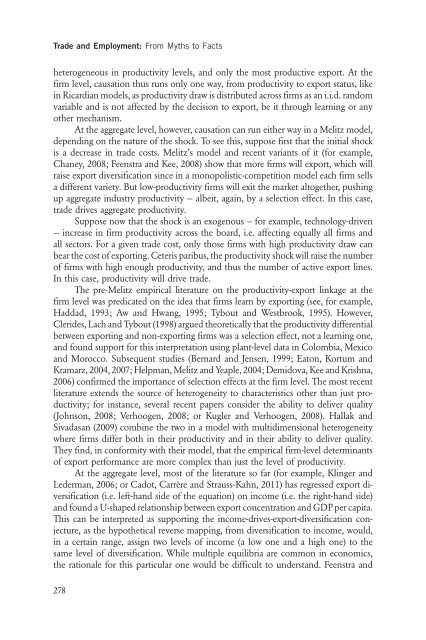Trade and Employment From Myths to Facts - International Labour ...
Trade and Employment From Myths to Facts - International Labour ...
Trade and Employment From Myths to Facts - International Labour ...
You also want an ePaper? Increase the reach of your titles
YUMPU automatically turns print PDFs into web optimized ePapers that Google loves.
<strong>Trade</strong> <strong>and</strong> <strong>Employment</strong>: <strong>From</strong> <strong>Myths</strong> <strong>to</strong> <strong>Facts</strong><br />
heterogeneous in productivity levels, <strong>and</strong> only the most productive export. At the<br />
firm level, causation thus runs only one way, from productivity <strong>to</strong> export status, like<br />
in Ricardian models, as productivity draw is distributed across firms as an i.i.d. r<strong>and</strong>om<br />
variable <strong>and</strong> is not affected by the decision <strong>to</strong> export, be it through learning or any<br />
other mechanism.<br />
At the aggregate level, however, causation can run either way in a Melitz model,<br />
depending on the nature of the shock. To see this, suppose first that the initial shock<br />
is a decrease in trade costs. Melitz’s model <strong>and</strong> recent variants of it (for example,<br />
Chaney, 2008; Feenstra <strong>and</strong> Kee, 2008) show that more firms will export, which will<br />
raise export diversification since in a monopolistic-competition model each firm sells<br />
a different variety. But low-productivity firms will exit the market al<strong>to</strong>gether, pushing<br />
up aggregate industry productivity — albeit, again, by a selection effect. In this case,<br />
trade drives aggregate productivity.<br />
Suppose now that the shock is an exogenous — for example, technology-driven<br />
— increase in firm productivity across the board, i.e. affecting equally all firms <strong>and</strong><br />
all sec<strong>to</strong>rs. For a given trade cost, only those firms with high productivity draw can<br />
bear the cost of exporting. Ceteris paribus, the productivity shock will raise the number<br />
of firms with high enough productivity, <strong>and</strong> thus the number of active export lines.<br />
In this case, productivity will drive trade.<br />
The pre-Melitz empirical literature on the productivity-export linkage at the<br />
firm level was predicated on the idea that firms learn by exporting (see, for example,<br />
Haddad, 1993; Aw <strong>and</strong> Hwang, 1995; Tybout <strong>and</strong> Westbrook, 1995). However,<br />
Clerides, Lach <strong>and</strong> Tybout (1998) argued theoretically that the productivity differential<br />
between exporting <strong>and</strong> non-exporting firms was a selection effect, not a learning one,<br />
<strong>and</strong> found support for this interpretation using plant-level data in Colombia, Mexico<br />
<strong>and</strong> Morocco. Subsequent studies (Bernard <strong>and</strong> Jensen, 1999; Ea<strong>to</strong>n, Kortum <strong>and</strong><br />
Kramarz, 2004, 2007; Helpman, Melitz <strong>and</strong> Yeaple, 2004; Demidova, Kee <strong>and</strong> Krishna,<br />
2006) confirmed the importance of selection effects at the firm level. The most recent<br />
literature extends the source of heterogeneity <strong>to</strong> characteristics other than just productivity;<br />
for instance, several recent papers consider the ability <strong>to</strong> deliver quality<br />
(Johnson, 2008; Verhoogen, 2008; or Kugler <strong>and</strong> Verhoogen, 2008). Hallak <strong>and</strong><br />
Sivadasan (2009) combine the two in a model with multidimensional heterogeneity<br />
where firms differ both in their productivity <strong>and</strong> in their ability <strong>to</strong> deliver quality.<br />
They find, in conformity with their model, that the empirical firm-level determinants<br />
of export performance are more complex than just the level of productivity.<br />
At the aggregate level, most of the literature so far (for example, Klinger <strong>and</strong><br />
Lederman, 2006; or Cadot, Carrère <strong>and</strong> Strauss-Kahn, 2011) has regressed export diversification<br />
(i.e. left-h<strong>and</strong> side of the equation) on income (i.e. the right-h<strong>and</strong> side)<br />
<strong>and</strong> found a U-shaped relationship between export concentration <strong>and</strong> GDP per capita.<br />
This can be interpreted as supporting the income-drives-export-diversification conjecture,<br />
as the hypothetical reverse mapping, from diversification <strong>to</strong> income, would,<br />
in a certain range, assign two levels of income (a low one <strong>and</strong> a high one) <strong>to</strong> the<br />
same level of diversification. While multiple equilibria are common in economics,<br />
the rationale for this particular one would be difficult <strong>to</strong> underst<strong>and</strong>. Feenstra <strong>and</strong><br />
278

















